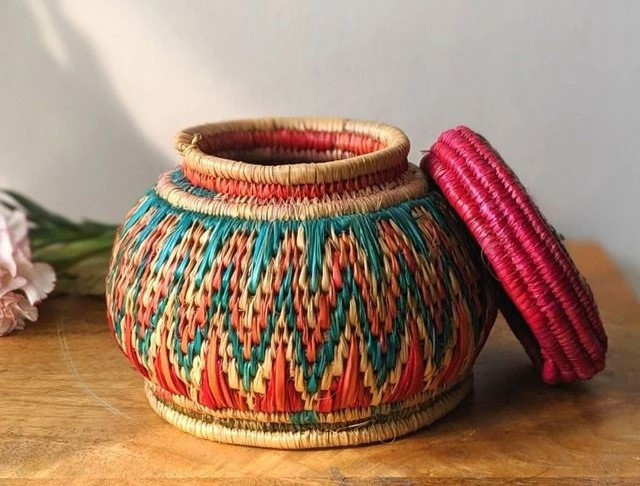Sikki crafts have their origin from the states of Bihar and Uttar Pradesh of India. It is the art of making craft items out of Sikki grass which is considered to be auspicious by the natives of Bihar. These are weaved into various items like ornaments and certain daily used essential items. In earlier times, the qualifications of women in these areas were judged by the amount of knowledge and skills they had in making Sikki crafts. It is considered as one of the most beautiful arts made from beautiful golden grass which makes the crafts highly attractive.
The Sikki grass has a golden tint and grows in the marshy areas near water bodies during a particular season. The grass is cut and then dried in sunlight when it reaches a certain height.
How Are The Crafts Made?
The Sikki crafts are made with Sikki grass and along with it, other two kinds of grass called Khar and Munj are added. The sikki is coiled around the Munj, giving the craft its basic shape and then colors are added by boiling in dyes of red, blue, gold, or black.
The preparation of the Sikki crafts starts with taking the Munj as the base frame as per the design requirements. Then with a 6-inch long needle, called Takua is used when the Sikki strands are woven around. The needle is generally made of wood or lacquerware which makes its grip comfortable and the Sikki strands are split by cutting with a knife or scissor.
To moisten the grass so that it becomes easy to turn around the structure of Munj, water is used. The artist weaves in such a fine way, that the base of Munj becomes completely invisible and they keep weaving with multicolor laces of Sikki until the desired pattern is obtained. Various replicas of Gods and Goddesses, patterns of animals, birds, or the models of chariot and many such other amazing crafts are created with the help of the Golden grass.
Diversity of Sikki Grass Products:
With the advent of plastic products, however, the demand for Sikki products has declined to a certain extent. But with the contribution of many people towards its development, the products of Sikki such as flower bouquets, paperweights, ornaments, wall decor baskets, and many such other products grab the attention of the people instantly.
A kind of box made out of Sikki grass called Pauti is commonly used by the newlyweds to store Sindoor or Jewellery given by the parents. At times, dolls and various types of toys are also made from Sikki grass.
Along with its varied uses, the items made of Sikki grass also hold religious importance for the natives of Bihar. Toys made of Sikki grass are mandatory for a local festival of many regions, known as Chakeva which demonstrates the beautiful bond between brother and sister.
Big containers which are usually used to store food items called Jhappa are also made from Sikki grass. Also, to hold vegetables or fruits, bowl-like containers are made which are called Gumla, and trays called Mauni are also made from the golden grass.
Main Centers Of Sikki Craft :
Although the Sikki crafts are found predominantly in Bihar, the centers of their availability have widened at present times. In Bihar, the major centers where these crafts are found are Jayanagar, Katihar, Rampur, Siddhi, Darbhanga, East Champaran, and many other regions. Nowadays, the Tharu women hailing from Nepal also produce Sikki crafts with the help of huge networks and collaboration.
Prominent Artists and Their Contributions:
The Sikki craft was also uplifted by Dhirendra Kumar with his innovative ways as he started Sikki art on the canvas itself. Sketching with Sikki grass is one of the most difficult tasks, but he made it possible with his untiring efforts. There are also names of many personalities who, with their diligence and hard work, received national awards in Sikki Arts. They are Late Vindevari Devi, Munni Devi, Krishna Devi, Meera Thakur, and many others.
Sikki Products Proffering Eco-Friendly Lifestyle
The sikki crafts are eco-friendly along with being lightweight and organic. These biodegradable products are highly efficient as they come with longer durability so that they can be used till wanted by the users. The craft has its beliefs deeply rooted in Indian tradition and for the present world, the situation is the best example of sustainability. With the hazardous effects of plastics on the environment, items made of organic materials like Sikki grass can be a good substitute for plastics.
Being handwoven, these crafts require much hard work and also time to get the final products which make these a but higher range than the plastic products. But these products along with being sustainable and biodegradable, also adds to an exquisite look of the entire décor of your home. Moreover, by buying these products, you will be supporting local weavers of India and the arts of Indian culture.
Picture Source: ArtsofIndia.in



